Gender Inequality and Taxable Income
VerifiedAdded on 2020/04/01
|18
|3749
|217
AI Summary
This assignment analyzes the presence of gender inequality in terms of taxable income across different industries. It examines data to compare average incomes earned by men and women in various sectors, highlighting discrepancies and potential contributing factors. The analysis reveals that while women are employed in numerous industries, they often earn less than their male counterparts. The only exceptions are the accommodation and food services, and construction industries, where women's earnings sometimes exceed those of men.
Contribute Materials
Your contribution can guide someone’s learning journey. Share your
documents today.
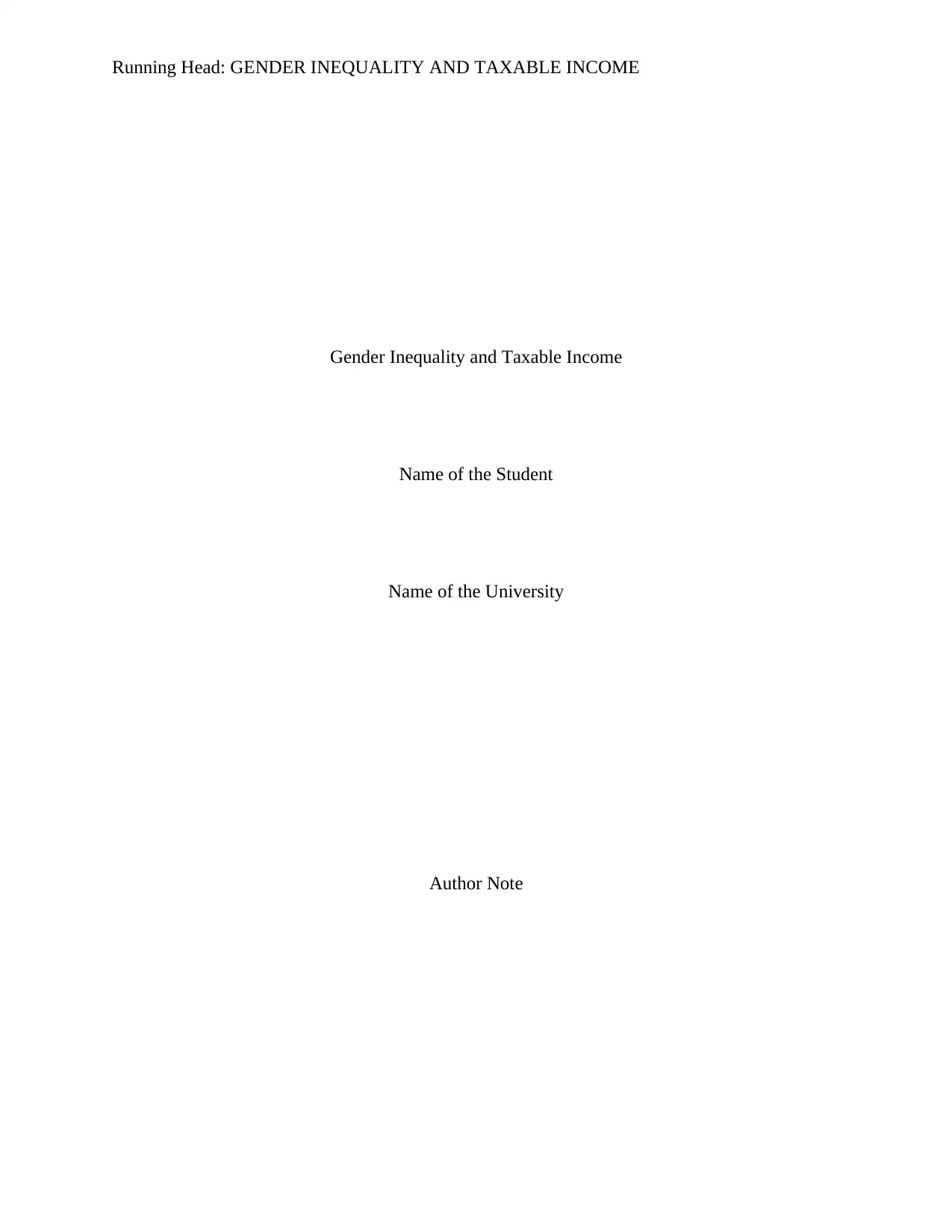
Running Head: GENDER INEQUALITY AND TAXABLE INCOME
Gender Inequality and Taxable Income
Name of the Student
Name of the University
Author Note
Gender Inequality and Taxable Income
Name of the Student
Name of the University
Author Note
Secure Best Marks with AI Grader
Need help grading? Try our AI Grader for instant feedback on your assignments.
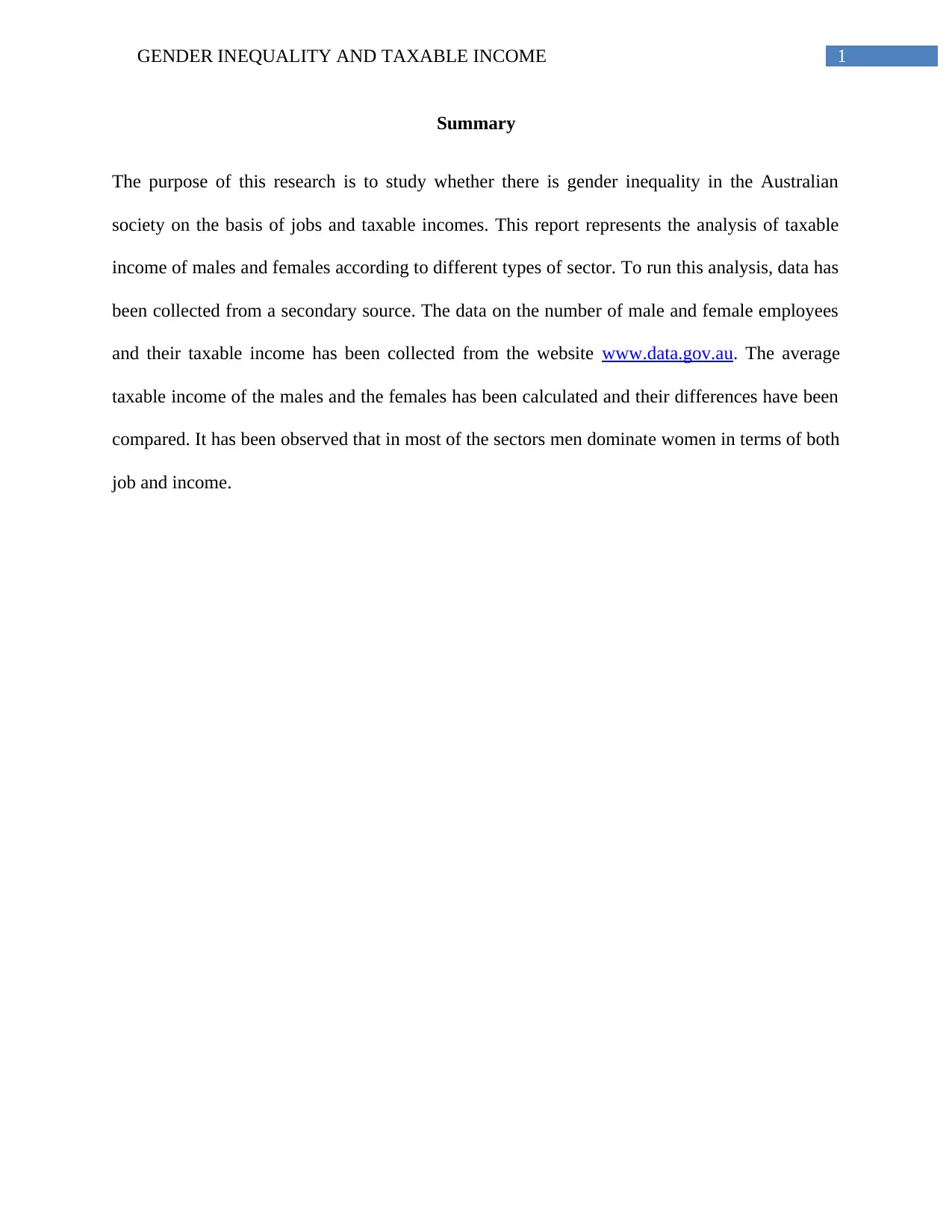
1GENDER INEQUALITY AND TAXABLE INCOME
Summary
The purpose of this research is to study whether there is gender inequality in the Australian
society on the basis of jobs and taxable incomes. This report represents the analysis of taxable
income of males and females according to different types of sector. To run this analysis, data has
been collected from a secondary source. The data on the number of male and female employees
and their taxable income has been collected from the website www.data.gov.au. The average
taxable income of the males and the females has been calculated and their differences have been
compared. It has been observed that in most of the sectors men dominate women in terms of both
job and income.
Summary
The purpose of this research is to study whether there is gender inequality in the Australian
society on the basis of jobs and taxable incomes. This report represents the analysis of taxable
income of males and females according to different types of sector. To run this analysis, data has
been collected from a secondary source. The data on the number of male and female employees
and their taxable income has been collected from the website www.data.gov.au. The average
taxable income of the males and the females has been calculated and their differences have been
compared. It has been observed that in most of the sectors men dominate women in terms of both
job and income.
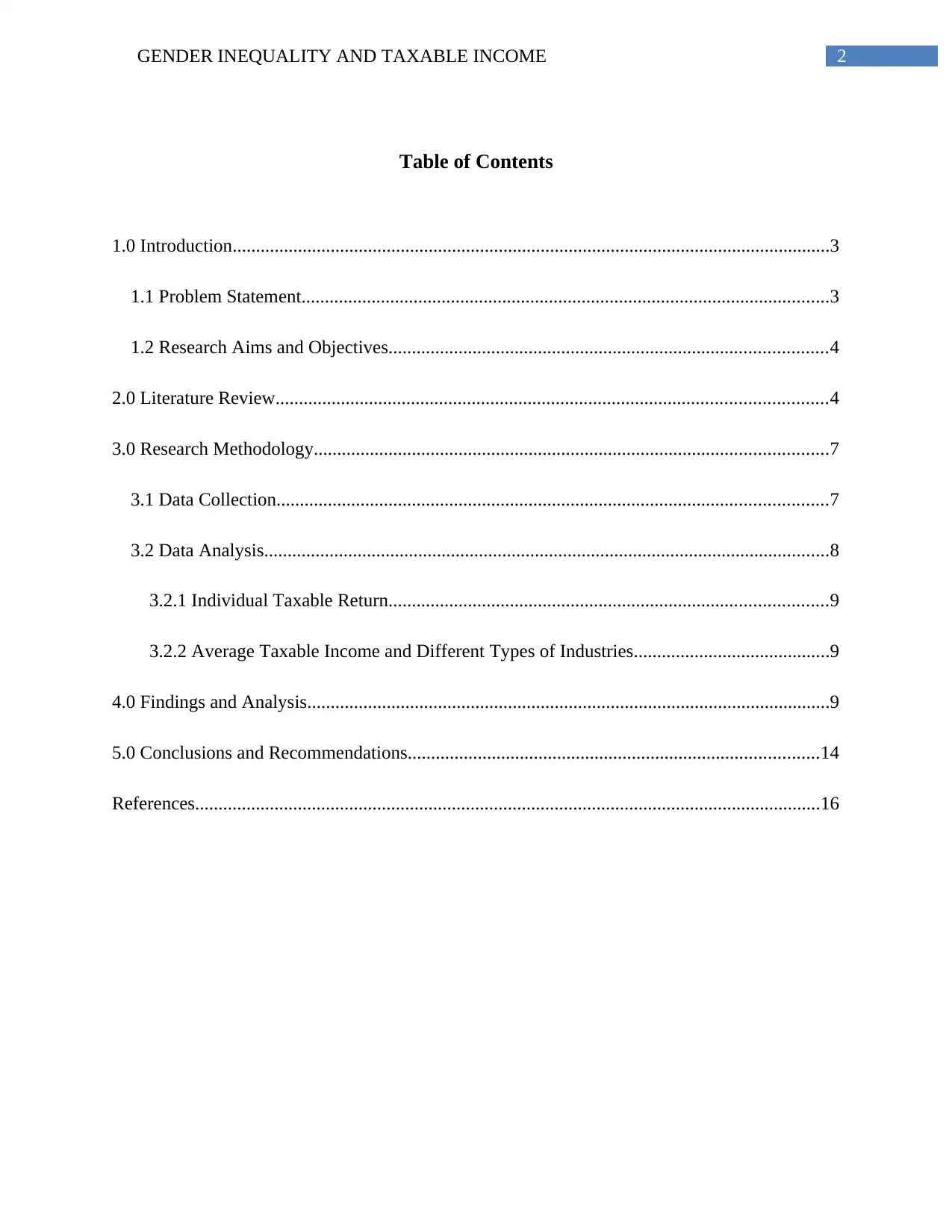
2GENDER INEQUALITY AND TAXABLE INCOME
Table of Contents
1.0 Introduction................................................................................................................................3
1.1 Problem Statement.................................................................................................................3
1.2 Research Aims and Objectives..............................................................................................4
2.0 Literature Review......................................................................................................................4
3.0 Research Methodology..............................................................................................................7
3.1 Data Collection......................................................................................................................7
3.2 Data Analysis.........................................................................................................................8
3.2.1 Individual Taxable Return..............................................................................................9
3.2.2 Average Taxable Income and Different Types of Industries..........................................9
4.0 Findings and Analysis................................................................................................................9
5.0 Conclusions and Recommendations........................................................................................14
References......................................................................................................................................16
Table of Contents
1.0 Introduction................................................................................................................................3
1.1 Problem Statement.................................................................................................................3
1.2 Research Aims and Objectives..............................................................................................4
2.0 Literature Review......................................................................................................................4
3.0 Research Methodology..............................................................................................................7
3.1 Data Collection......................................................................................................................7
3.2 Data Analysis.........................................................................................................................8
3.2.1 Individual Taxable Return..............................................................................................9
3.2.2 Average Taxable Income and Different Types of Industries..........................................9
4.0 Findings and Analysis................................................................................................................9
5.0 Conclusions and Recommendations........................................................................................14
References......................................................................................................................................16
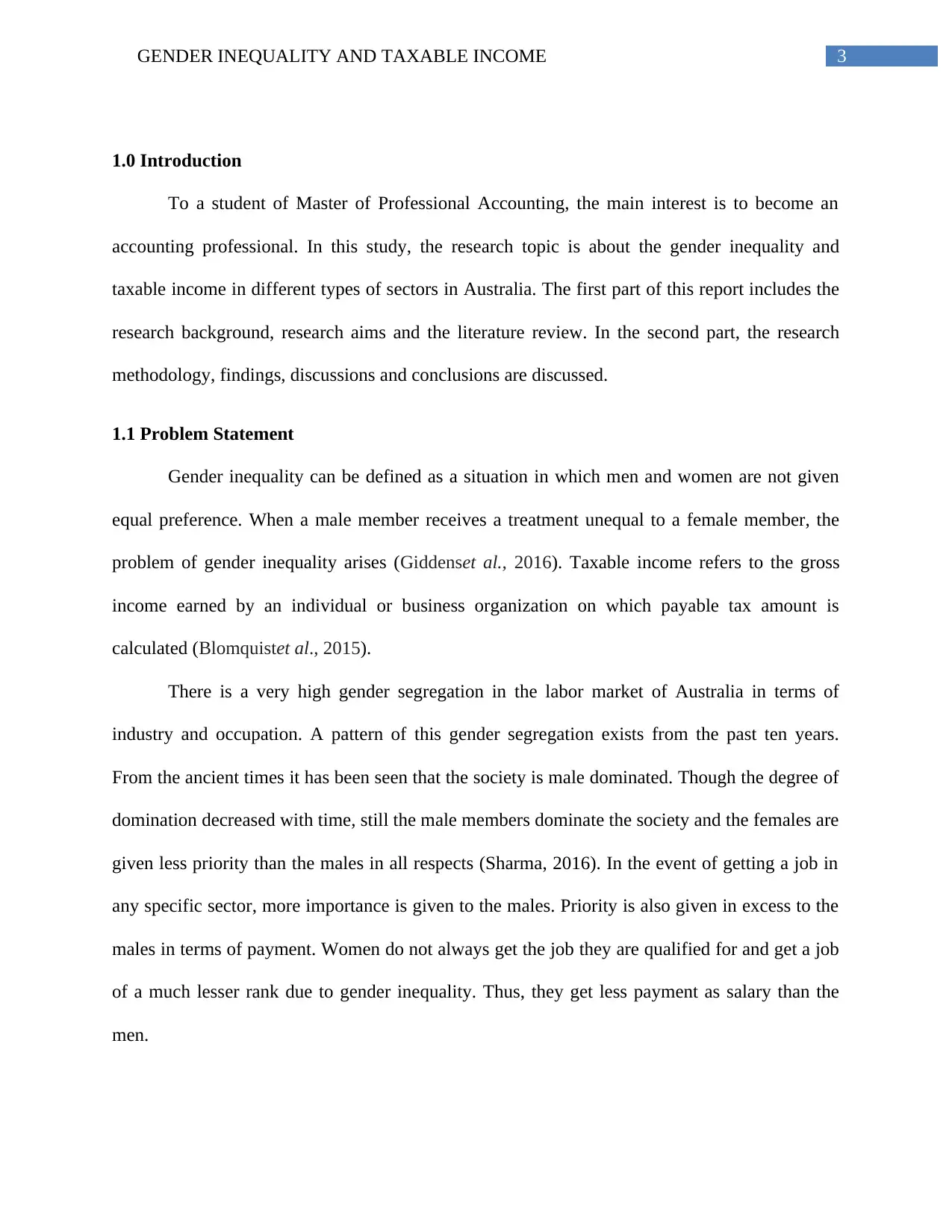
3GENDER INEQUALITY AND TAXABLE INCOME
1.0 Introduction
To a student of Master of Professional Accounting, the main interest is to become an
accounting professional. In this study, the research topic is about the gender inequality and
taxable income in different types of sectors in Australia. The first part of this report includes the
research background, research aims and the literature review. In the second part, the research
methodology, findings, discussions and conclusions are discussed.
1.1 Problem Statement
Gender inequality can be defined as a situation in which men and women are not given
equal preference. When a male member receives a treatment unequal to a female member, the
problem of gender inequality arises (Giddenset al., 2016). Taxable income refers to the gross
income earned by an individual or business organization on which payable tax amount is
calculated (Blomquistet al., 2015).
There is a very high gender segregation in the labor market of Australia in terms of
industry and occupation. A pattern of this gender segregation exists from the past ten years.
From the ancient times it has been seen that the society is male dominated. Though the degree of
domination decreased with time, still the male members dominate the society and the females are
given less priority than the males in all respects (Sharma, 2016). In the event of getting a job in
any specific sector, more importance is given to the males. Priority is also given in excess to the
males in terms of payment. Women do not always get the job they are qualified for and get a job
of a much lesser rank due to gender inequality. Thus, they get less payment as salary than the
men.
1.0 Introduction
To a student of Master of Professional Accounting, the main interest is to become an
accounting professional. In this study, the research topic is about the gender inequality and
taxable income in different types of sectors in Australia. The first part of this report includes the
research background, research aims and the literature review. In the second part, the research
methodology, findings, discussions and conclusions are discussed.
1.1 Problem Statement
Gender inequality can be defined as a situation in which men and women are not given
equal preference. When a male member receives a treatment unequal to a female member, the
problem of gender inequality arises (Giddenset al., 2016). Taxable income refers to the gross
income earned by an individual or business organization on which payable tax amount is
calculated (Blomquistet al., 2015).
There is a very high gender segregation in the labor market of Australia in terms of
industry and occupation. A pattern of this gender segregation exists from the past ten years.
From the ancient times it has been seen that the society is male dominated. Though the degree of
domination decreased with time, still the male members dominate the society and the females are
given less priority than the males in all respects (Sharma, 2016). In the event of getting a job in
any specific sector, more importance is given to the males. Priority is also given in excess to the
males in terms of payment. Women do not always get the job they are qualified for and get a job
of a much lesser rank due to gender inequality. Thus, they get less payment as salary than the
men.
Secure Best Marks with AI Grader
Need help grading? Try our AI Grader for instant feedback on your assignments.
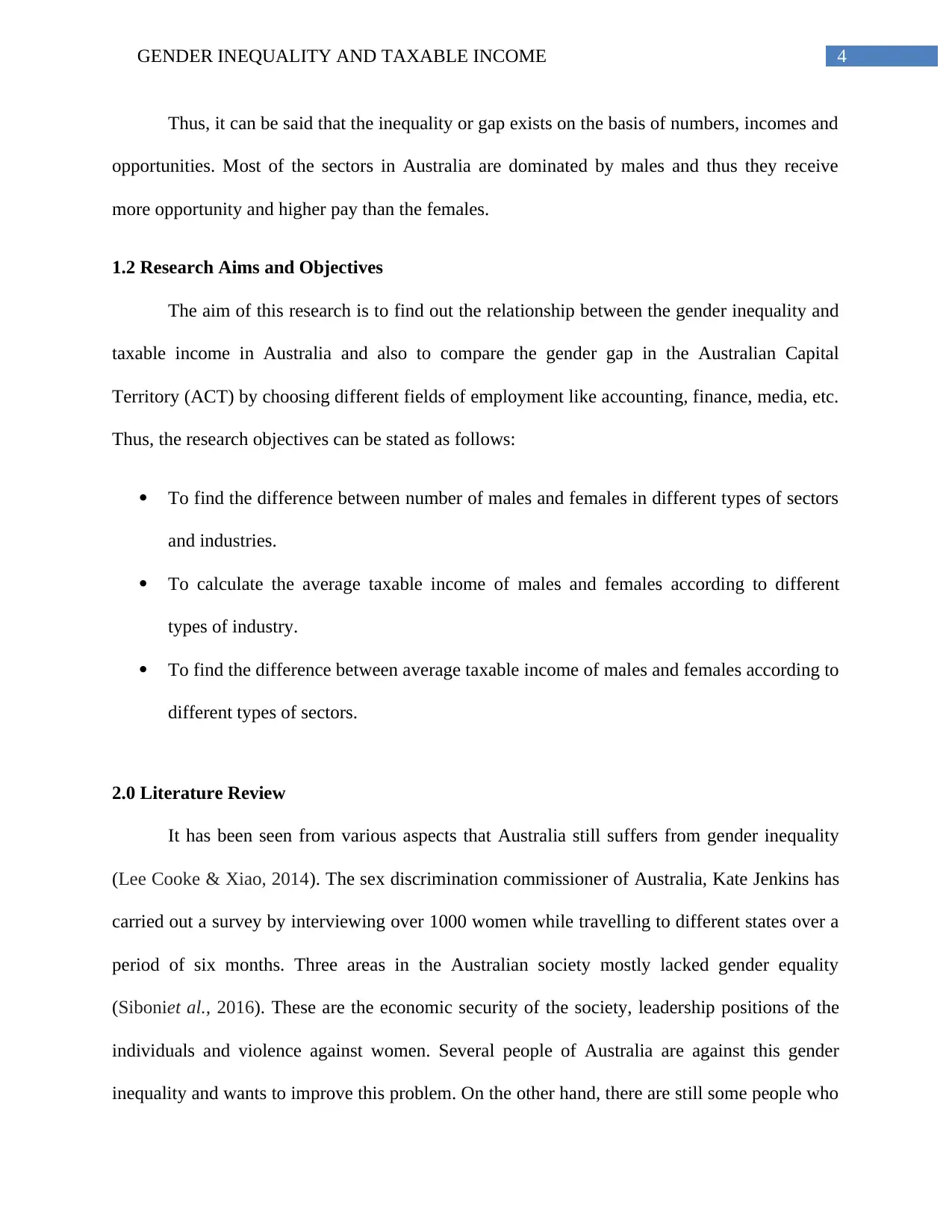
4GENDER INEQUALITY AND TAXABLE INCOME
Thus, it can be said that the inequality or gap exists on the basis of numbers, incomes and
opportunities. Most of the sectors in Australia are dominated by males and thus they receive
more opportunity and higher pay than the females.
1.2 Research Aims and Objectives
The aim of this research is to find out the relationship between the gender inequality and
taxable income in Australia and also to compare the gender gap in the Australian Capital
Territory (ACT) by choosing different fields of employment like accounting, finance, media, etc.
Thus, the research objectives can be stated as follows:
To find the difference between number of males and females in different types of sectors
and industries.
To calculate the average taxable income of males and females according to different
types of industry.
To find the difference between average taxable income of males and females according to
different types of sectors.
2.0 Literature Review
It has been seen from various aspects that Australia still suffers from gender inequality
(Lee Cooke & Xiao, 2014). The sex discrimination commissioner of Australia, Kate Jenkins has
carried out a survey by interviewing over 1000 women while travelling to different states over a
period of six months. Three areas in the Australian society mostly lacked gender equality
(Siboniet al., 2016). These are the economic security of the society, leadership positions of the
individuals and violence against women. Several people of Australia are against this gender
inequality and wants to improve this problem. On the other hand, there are still some people who
Thus, it can be said that the inequality or gap exists on the basis of numbers, incomes and
opportunities. Most of the sectors in Australia are dominated by males and thus they receive
more opportunity and higher pay than the females.
1.2 Research Aims and Objectives
The aim of this research is to find out the relationship between the gender inequality and
taxable income in Australia and also to compare the gender gap in the Australian Capital
Territory (ACT) by choosing different fields of employment like accounting, finance, media, etc.
Thus, the research objectives can be stated as follows:
To find the difference between number of males and females in different types of sectors
and industries.
To calculate the average taxable income of males and females according to different
types of industry.
To find the difference between average taxable income of males and females according to
different types of sectors.
2.0 Literature Review
It has been seen from various aspects that Australia still suffers from gender inequality
(Lee Cooke & Xiao, 2014). The sex discrimination commissioner of Australia, Kate Jenkins has
carried out a survey by interviewing over 1000 women while travelling to different states over a
period of six months. Three areas in the Australian society mostly lacked gender equality
(Siboniet al., 2016). These are the economic security of the society, leadership positions of the
individuals and violence against women. Several people of Australia are against this gender
inequality and wants to improve this problem. On the other hand, there are still some people who
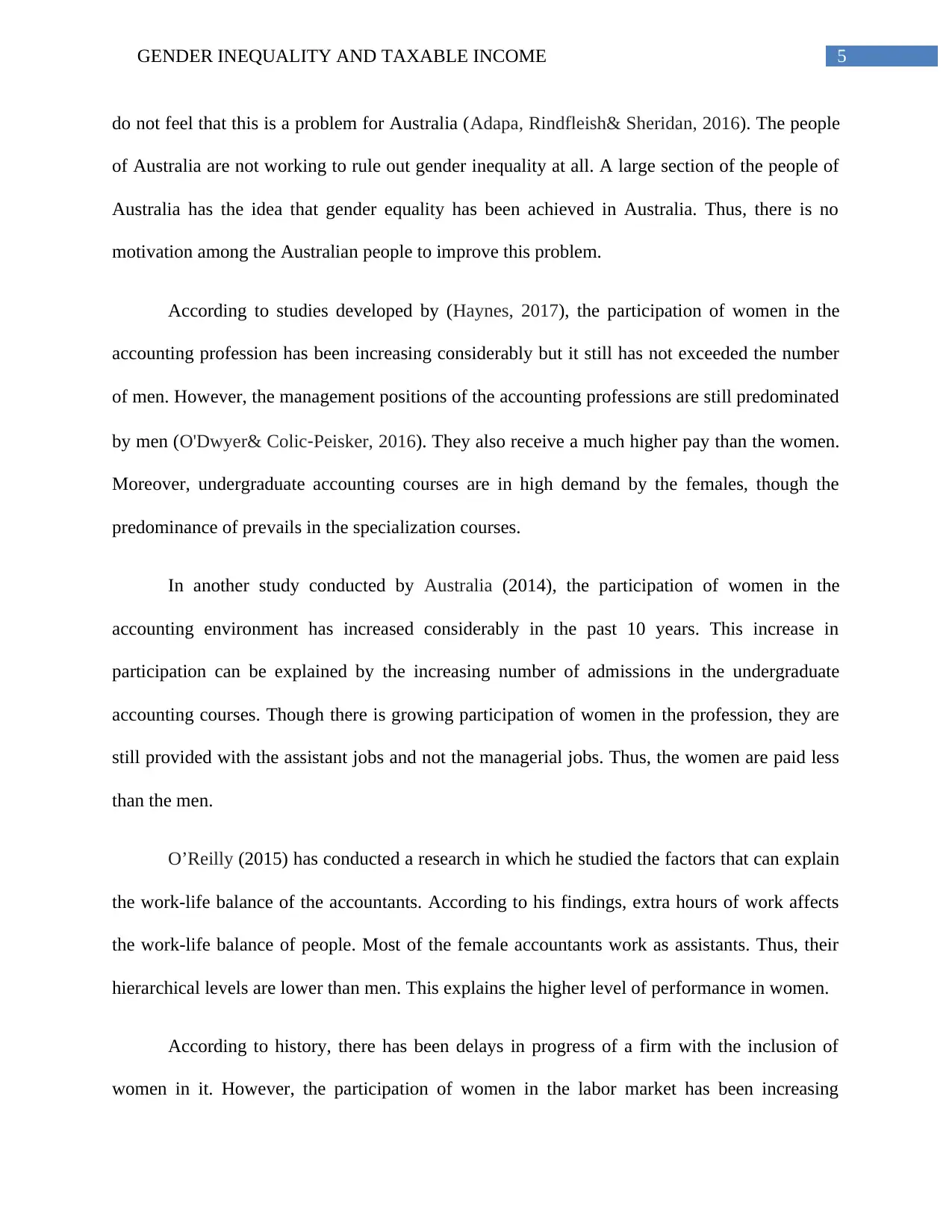
5GENDER INEQUALITY AND TAXABLE INCOME
do not feel that this is a problem for Australia (Adapa, Rindfleish& Sheridan, 2016). The people
of Australia are not working to rule out gender inequality at all. A large section of the people of
Australia has the idea that gender equality has been achieved in Australia. Thus, there is no
motivation among the Australian people to improve this problem.
According to studies developed by (Haynes, 2017), the participation of women in the
accounting profession has been increasing considerably but it still has not exceeded the number
of men. However, the management positions of the accounting professions are still predominated
by men (O'Dwyer& Colic‐Peisker, 2016). They also receive a much higher pay than the women.
Moreover, undergraduate accounting courses are in high demand by the females, though the
predominance of prevails in the specialization courses.
In another study conducted by Australia (2014), the participation of women in the
accounting environment has increased considerably in the past 10 years. This increase in
participation can be explained by the increasing number of admissions in the undergraduate
accounting courses. Though there is growing participation of women in the profession, they are
still provided with the assistant jobs and not the managerial jobs. Thus, the women are paid less
than the men.
O’Reilly (2015) has conducted a research in which he studied the factors that can explain
the work-life balance of the accountants. According to his findings, extra hours of work affects
the work-life balance of people. Most of the female accountants work as assistants. Thus, their
hierarchical levels are lower than men. This explains the higher level of performance in women.
According to history, there has been delays in progress of a firm with the inclusion of
women in it. However, the participation of women in the labor market has been increasing
do not feel that this is a problem for Australia (Adapa, Rindfleish& Sheridan, 2016). The people
of Australia are not working to rule out gender inequality at all. A large section of the people of
Australia has the idea that gender equality has been achieved in Australia. Thus, there is no
motivation among the Australian people to improve this problem.
According to studies developed by (Haynes, 2017), the participation of women in the
accounting profession has been increasing considerably but it still has not exceeded the number
of men. However, the management positions of the accounting professions are still predominated
by men (O'Dwyer& Colic‐Peisker, 2016). They also receive a much higher pay than the women.
Moreover, undergraduate accounting courses are in high demand by the females, though the
predominance of prevails in the specialization courses.
In another study conducted by Australia (2014), the participation of women in the
accounting environment has increased considerably in the past 10 years. This increase in
participation can be explained by the increasing number of admissions in the undergraduate
accounting courses. Though there is growing participation of women in the profession, they are
still provided with the assistant jobs and not the managerial jobs. Thus, the women are paid less
than the men.
O’Reilly (2015) has conducted a research in which he studied the factors that can explain
the work-life balance of the accountants. According to his findings, extra hours of work affects
the work-life balance of people. Most of the female accountants work as assistants. Thus, their
hierarchical levels are lower than men. This explains the higher level of performance in women.
According to history, there has been delays in progress of a firm with the inclusion of
women in it. However, the participation of women in the labor market has been increasing
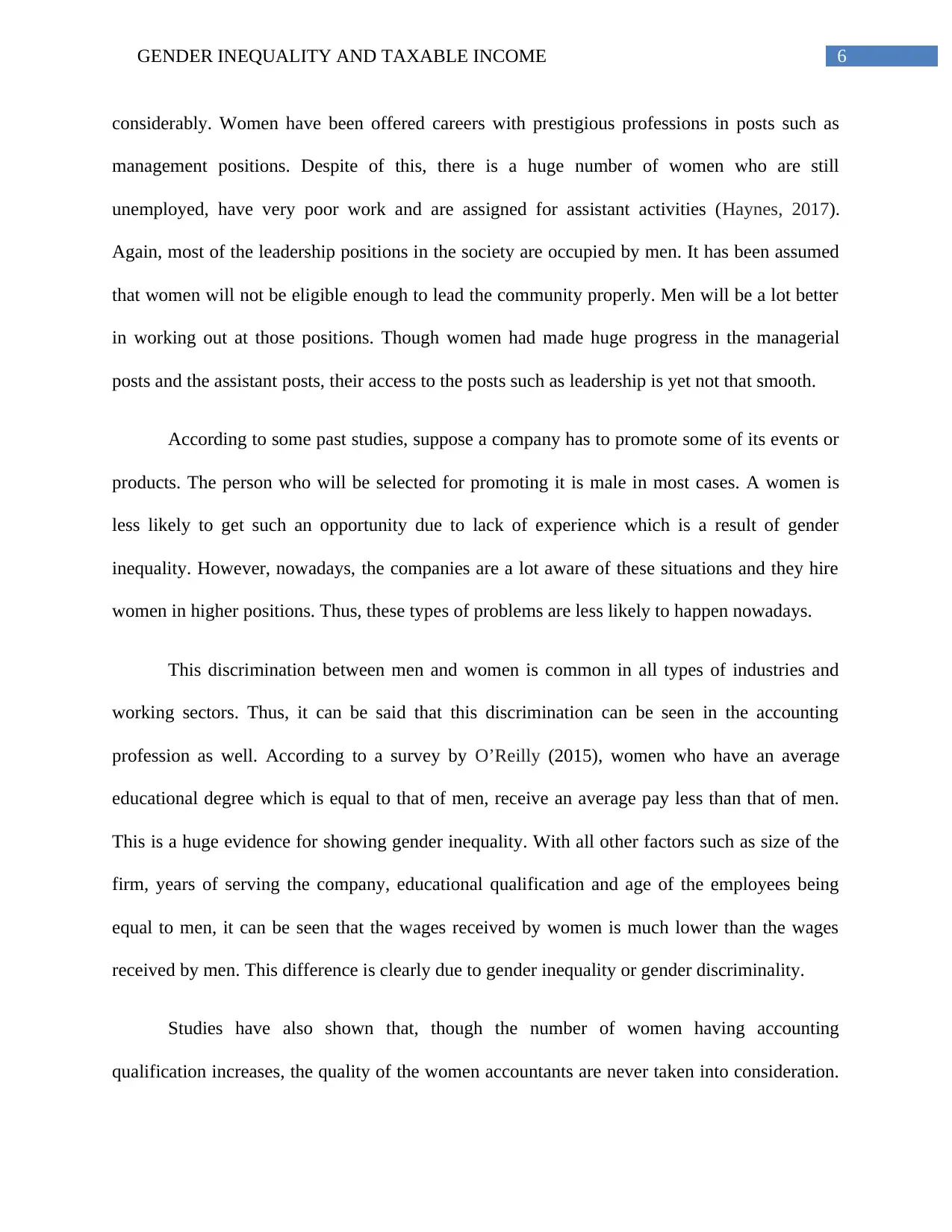
6GENDER INEQUALITY AND TAXABLE INCOME
considerably. Women have been offered careers with prestigious professions in posts such as
management positions. Despite of this, there is a huge number of women who are still
unemployed, have very poor work and are assigned for assistant activities (Haynes, 2017).
Again, most of the leadership positions in the society are occupied by men. It has been assumed
that women will not be eligible enough to lead the community properly. Men will be a lot better
in working out at those positions. Though women had made huge progress in the managerial
posts and the assistant posts, their access to the posts such as leadership is yet not that smooth.
According to some past studies, suppose a company has to promote some of its events or
products. The person who will be selected for promoting it is male in most cases. A women is
less likely to get such an opportunity due to lack of experience which is a result of gender
inequality. However, nowadays, the companies are a lot aware of these situations and they hire
women in higher positions. Thus, these types of problems are less likely to happen nowadays.
This discrimination between men and women is common in all types of industries and
working sectors. Thus, it can be said that this discrimination can be seen in the accounting
profession as well. According to a survey by O’Reilly (2015), women who have an average
educational degree which is equal to that of men, receive an average pay less than that of men.
This is a huge evidence for showing gender inequality. With all other factors such as size of the
firm, years of serving the company, educational qualification and age of the employees being
equal to men, it can be seen that the wages received by women is much lower than the wages
received by men. This difference is clearly due to gender inequality or gender discriminality.
Studies have also shown that, though the number of women having accounting
qualification increases, the quality of the women accountants are never taken into consideration.
considerably. Women have been offered careers with prestigious professions in posts such as
management positions. Despite of this, there is a huge number of women who are still
unemployed, have very poor work and are assigned for assistant activities (Haynes, 2017).
Again, most of the leadership positions in the society are occupied by men. It has been assumed
that women will not be eligible enough to lead the community properly. Men will be a lot better
in working out at those positions. Though women had made huge progress in the managerial
posts and the assistant posts, their access to the posts such as leadership is yet not that smooth.
According to some past studies, suppose a company has to promote some of its events or
products. The person who will be selected for promoting it is male in most cases. A women is
less likely to get such an opportunity due to lack of experience which is a result of gender
inequality. However, nowadays, the companies are a lot aware of these situations and they hire
women in higher positions. Thus, these types of problems are less likely to happen nowadays.
This discrimination between men and women is common in all types of industries and
working sectors. Thus, it can be said that this discrimination can be seen in the accounting
profession as well. According to a survey by O’Reilly (2015), women who have an average
educational degree which is equal to that of men, receive an average pay less than that of men.
This is a huge evidence for showing gender inequality. With all other factors such as size of the
firm, years of serving the company, educational qualification and age of the employees being
equal to men, it can be seen that the wages received by women is much lower than the wages
received by men. This difference is clearly due to gender inequality or gender discriminality.
Studies have also shown that, though the number of women having accounting
qualification increases, the quality of the women accountants are never taken into consideration.
Paraphrase This Document
Need a fresh take? Get an instant paraphrase of this document with our AI Paraphraser
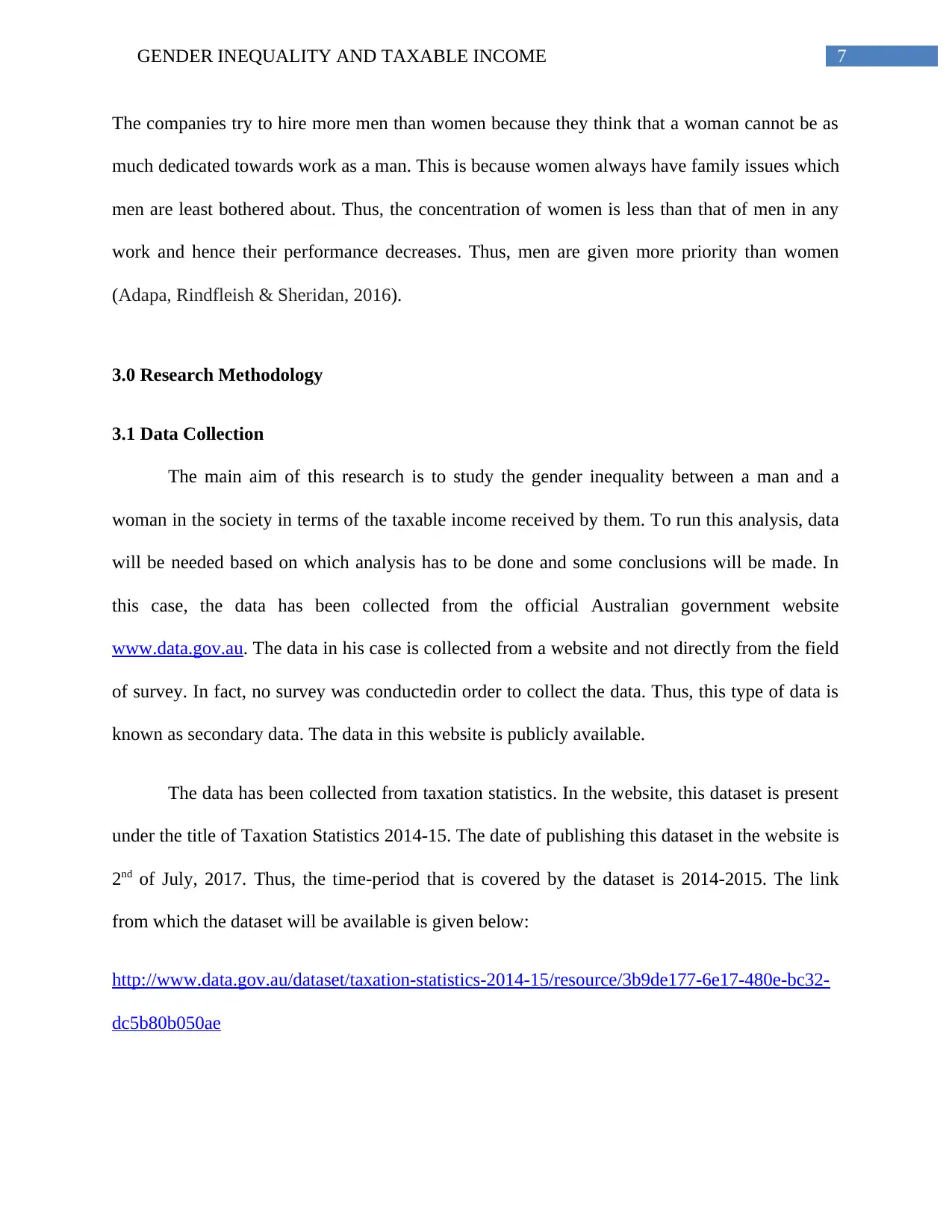
7GENDER INEQUALITY AND TAXABLE INCOME
The companies try to hire more men than women because they think that a woman cannot be as
much dedicated towards work as a man. This is because women always have family issues which
men are least bothered about. Thus, the concentration of women is less than that of men in any
work and hence their performance decreases. Thus, men are given more priority than women
(Adapa, Rindfleish & Sheridan, 2016).
3.0 Research Methodology
3.1 Data Collection
The main aim of this research is to study the gender inequality between a man and a
woman in the society in terms of the taxable income received by them. To run this analysis, data
will be needed based on which analysis has to be done and some conclusions will be made. In
this case, the data has been collected from the official Australian government website
www.data.gov.au. The data in his case is collected from a website and not directly from the field
of survey. In fact, no survey was conductedin order to collect the data. Thus, this type of data is
known as secondary data. The data in this website is publicly available.
The data has been collected from taxation statistics. In the website, this dataset is present
under the title of Taxation Statistics 2014-15. The date of publishing this dataset in the website is
2nd of July, 2017. Thus, the time-period that is covered by the dataset is 2014-2015. The link
from which the dataset will be available is given below:
http://www.data.gov.au/dataset/taxation-statistics-2014-15/resource/3b9de177-6e17-480e-bc32-
dc5b80b050ae
The companies try to hire more men than women because they think that a woman cannot be as
much dedicated towards work as a man. This is because women always have family issues which
men are least bothered about. Thus, the concentration of women is less than that of men in any
work and hence their performance decreases. Thus, men are given more priority than women
(Adapa, Rindfleish & Sheridan, 2016).
3.0 Research Methodology
3.1 Data Collection
The main aim of this research is to study the gender inequality between a man and a
woman in the society in terms of the taxable income received by them. To run this analysis, data
will be needed based on which analysis has to be done and some conclusions will be made. In
this case, the data has been collected from the official Australian government website
www.data.gov.au. The data in his case is collected from a website and not directly from the field
of survey. In fact, no survey was conductedin order to collect the data. Thus, this type of data is
known as secondary data. The data in this website is publicly available.
The data has been collected from taxation statistics. In the website, this dataset is present
under the title of Taxation Statistics 2014-15. The date of publishing this dataset in the website is
2nd of July, 2017. Thus, the time-period that is covered by the dataset is 2014-2015. The link
from which the dataset will be available is given below:
http://www.data.gov.au/dataset/taxation-statistics-2014-15/resource/3b9de177-6e17-480e-bc32-
dc5b80b050ae
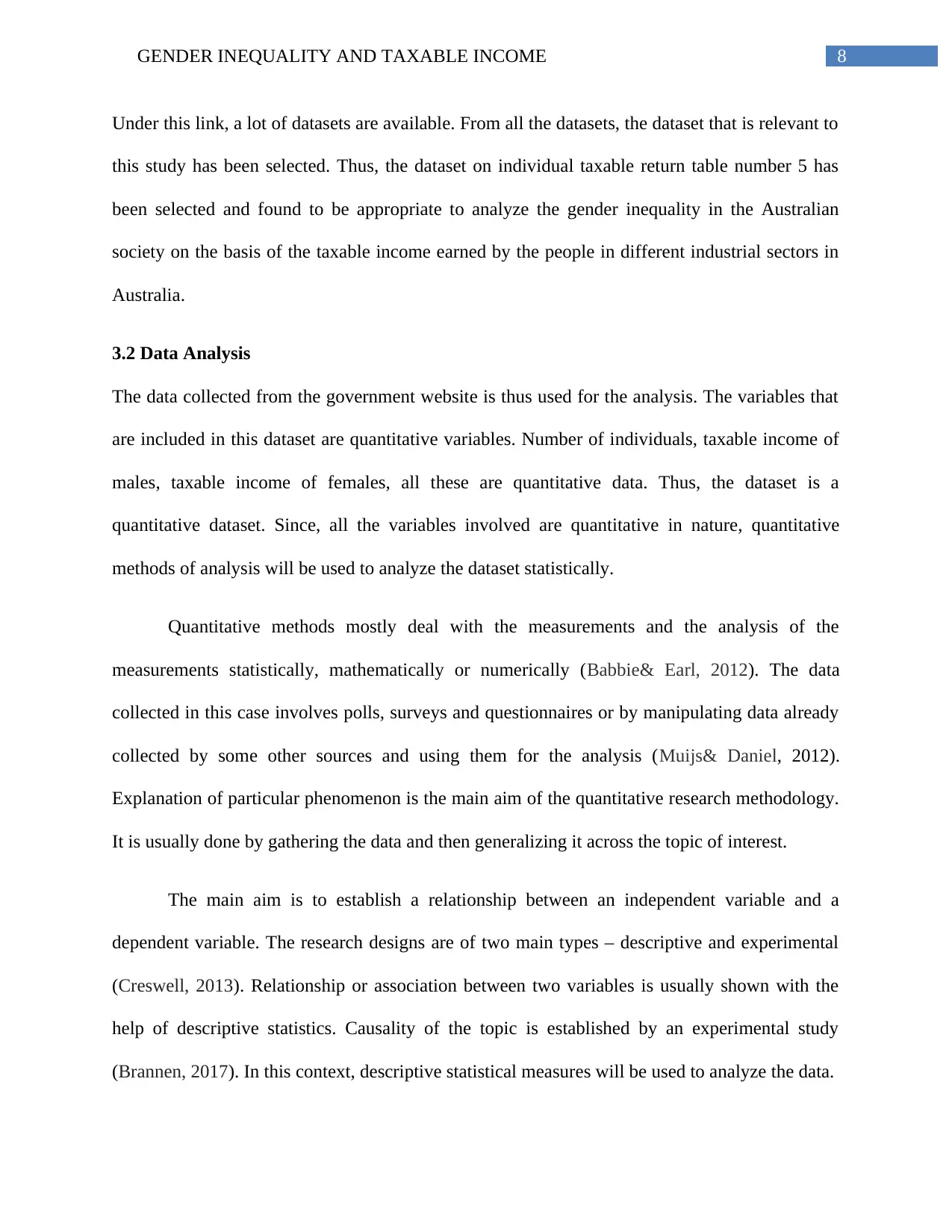
8GENDER INEQUALITY AND TAXABLE INCOME
Under this link, a lot of datasets are available. From all the datasets, the dataset that is relevant to
this study has been selected. Thus, the dataset on individual taxable return table number 5 has
been selected and found to be appropriate to analyze the gender inequality in the Australian
society on the basis of the taxable income earned by the people in different industrial sectors in
Australia.
3.2 Data Analysis
The data collected from the government website is thus used for the analysis. The variables that
are included in this dataset are quantitative variables. Number of individuals, taxable income of
males, taxable income of females, all these are quantitative data. Thus, the dataset is a
quantitative dataset. Since, all the variables involved are quantitative in nature, quantitative
methods of analysis will be used to analyze the dataset statistically.
Quantitative methods mostly deal with the measurements and the analysis of the
measurements statistically, mathematically or numerically (Babbie& Earl, 2012). The data
collected in this case involves polls, surveys and questionnaires or by manipulating data already
collected by some other sources and using them for the analysis (Muijs& Daniel, 2012).
Explanation of particular phenomenon is the main aim of the quantitative research methodology.
It is usually done by gathering the data and then generalizing it across the topic of interest.
The main aim is to establish a relationship between an independent variable and a
dependent variable. The research designs are of two main types – descriptive and experimental
(Creswell, 2013). Relationship or association between two variables is usually shown with the
help of descriptive statistics. Causality of the topic is established by an experimental study
(Brannen, 2017). In this context, descriptive statistical measures will be used to analyze the data.
Under this link, a lot of datasets are available. From all the datasets, the dataset that is relevant to
this study has been selected. Thus, the dataset on individual taxable return table number 5 has
been selected and found to be appropriate to analyze the gender inequality in the Australian
society on the basis of the taxable income earned by the people in different industrial sectors in
Australia.
3.2 Data Analysis
The data collected from the government website is thus used for the analysis. The variables that
are included in this dataset are quantitative variables. Number of individuals, taxable income of
males, taxable income of females, all these are quantitative data. Thus, the dataset is a
quantitative dataset. Since, all the variables involved are quantitative in nature, quantitative
methods of analysis will be used to analyze the dataset statistically.
Quantitative methods mostly deal with the measurements and the analysis of the
measurements statistically, mathematically or numerically (Babbie& Earl, 2012). The data
collected in this case involves polls, surveys and questionnaires or by manipulating data already
collected by some other sources and using them for the analysis (Muijs& Daniel, 2012).
Explanation of particular phenomenon is the main aim of the quantitative research methodology.
It is usually done by gathering the data and then generalizing it across the topic of interest.
The main aim is to establish a relationship between an independent variable and a
dependent variable. The research designs are of two main types – descriptive and experimental
(Creswell, 2013). Relationship or association between two variables is usually shown with the
help of descriptive statistics. Causality of the topic is established by an experimental study
(Brannen, 2017). In this context, descriptive statistical measures will be used to analyze the data.
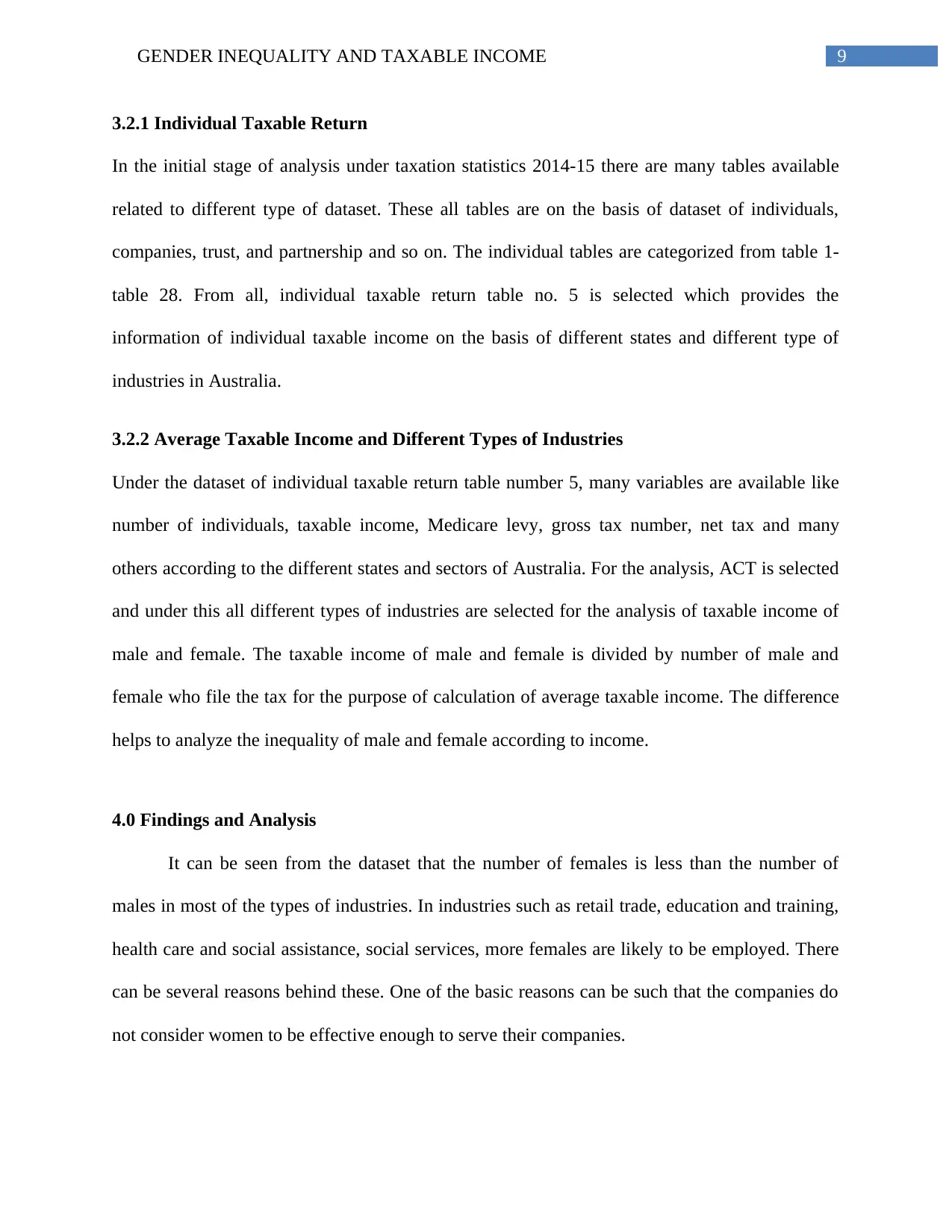
9GENDER INEQUALITY AND TAXABLE INCOME
3.2.1 Individual Taxable Return
In the initial stage of analysis under taxation statistics 2014-15 there are many tables available
related to different type of dataset. These all tables are on the basis of dataset of individuals,
companies, trust, and partnership and so on. The individual tables are categorized from table 1-
table 28. From all, individual taxable return table no. 5 is selected which provides the
information of individual taxable income on the basis of different states and different type of
industries in Australia.
3.2.2 Average Taxable Income and Different Types of Industries
Under the dataset of individual taxable return table number 5, many variables are available like
number of individuals, taxable income, Medicare levy, gross tax number, net tax and many
others according to the different states and sectors of Australia. For the analysis, ACT is selected
and under this all different types of industries are selected for the analysis of taxable income of
male and female. The taxable income of male and female is divided by number of male and
female who file the tax for the purpose of calculation of average taxable income. The difference
helps to analyze the inequality of male and female according to income.
4.0 Findings and Analysis
It can be seen from the dataset that the number of females is less than the number of
males in most of the types of industries. In industries such as retail trade, education and training,
health care and social assistance, social services, more females are likely to be employed. There
can be several reasons behind these. One of the basic reasons can be such that the companies do
not consider women to be effective enough to serve their companies.
3.2.1 Individual Taxable Return
In the initial stage of analysis under taxation statistics 2014-15 there are many tables available
related to different type of dataset. These all tables are on the basis of dataset of individuals,
companies, trust, and partnership and so on. The individual tables are categorized from table 1-
table 28. From all, individual taxable return table no. 5 is selected which provides the
information of individual taxable income on the basis of different states and different type of
industries in Australia.
3.2.2 Average Taxable Income and Different Types of Industries
Under the dataset of individual taxable return table number 5, many variables are available like
number of individuals, taxable income, Medicare levy, gross tax number, net tax and many
others according to the different states and sectors of Australia. For the analysis, ACT is selected
and under this all different types of industries are selected for the analysis of taxable income of
male and female. The taxable income of male and female is divided by number of male and
female who file the tax for the purpose of calculation of average taxable income. The difference
helps to analyze the inequality of male and female according to income.
4.0 Findings and Analysis
It can be seen from the dataset that the number of females is less than the number of
males in most of the types of industries. In industries such as retail trade, education and training,
health care and social assistance, social services, more females are likely to be employed. There
can be several reasons behind these. One of the basic reasons can be such that the companies do
not consider women to be effective enough to serve their companies.
Secure Best Marks with AI Grader
Need help grading? Try our AI Grader for instant feedback on your assignments.
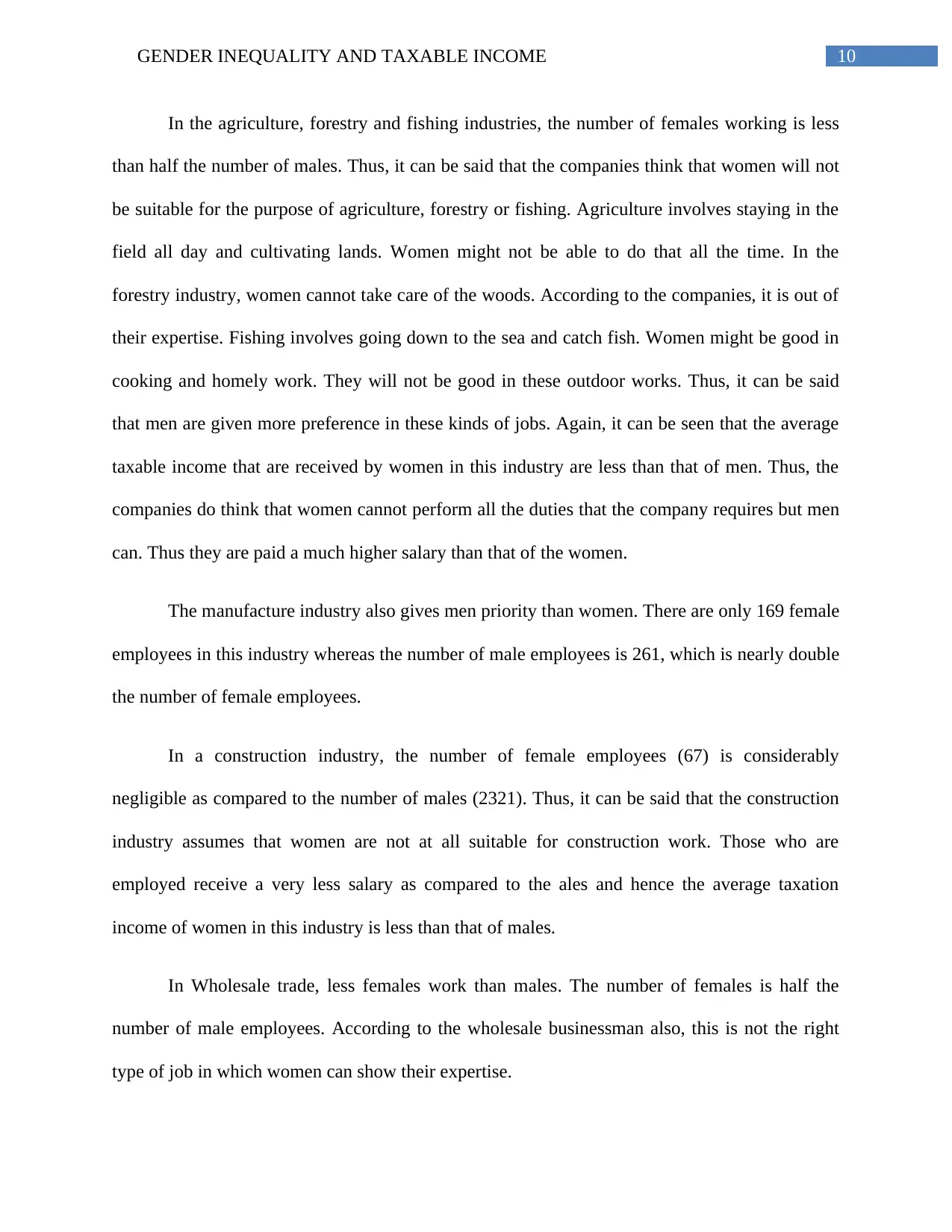
10GENDER INEQUALITY AND TAXABLE INCOME
In the agriculture, forestry and fishing industries, the number of females working is less
than half the number of males. Thus, it can be said that the companies think that women will not
be suitable for the purpose of agriculture, forestry or fishing. Agriculture involves staying in the
field all day and cultivating lands. Women might not be able to do that all the time. In the
forestry industry, women cannot take care of the woods. According to the companies, it is out of
their expertise. Fishing involves going down to the sea and catch fish. Women might be good in
cooking and homely work. They will not be good in these outdoor works. Thus, it can be said
that men are given more preference in these kinds of jobs. Again, it can be seen that the average
taxable income that are received by women in this industry are less than that of men. Thus, the
companies do think that women cannot perform all the duties that the company requires but men
can. Thus they are paid a much higher salary than that of the women.
The manufacture industry also gives men priority than women. There are only 169 female
employees in this industry whereas the number of male employees is 261, which is nearly double
the number of female employees.
In a construction industry, the number of female employees (67) is considerably
negligible as compared to the number of males (2321). Thus, it can be said that the construction
industry assumes that women are not at all suitable for construction work. Those who are
employed receive a very less salary as compared to the ales and hence the average taxation
income of women in this industry is less than that of males.
In Wholesale trade, less females work than males. The number of females is half the
number of male employees. According to the wholesale businessman also, this is not the right
type of job in which women can show their expertise.
In the agriculture, forestry and fishing industries, the number of females working is less
than half the number of males. Thus, it can be said that the companies think that women will not
be suitable for the purpose of agriculture, forestry or fishing. Agriculture involves staying in the
field all day and cultivating lands. Women might not be able to do that all the time. In the
forestry industry, women cannot take care of the woods. According to the companies, it is out of
their expertise. Fishing involves going down to the sea and catch fish. Women might be good in
cooking and homely work. They will not be good in these outdoor works. Thus, it can be said
that men are given more preference in these kinds of jobs. Again, it can be seen that the average
taxable income that are received by women in this industry are less than that of men. Thus, the
companies do think that women cannot perform all the duties that the company requires but men
can. Thus they are paid a much higher salary than that of the women.
The manufacture industry also gives men priority than women. There are only 169 female
employees in this industry whereas the number of male employees is 261, which is nearly double
the number of female employees.
In a construction industry, the number of female employees (67) is considerably
negligible as compared to the number of males (2321). Thus, it can be said that the construction
industry assumes that women are not at all suitable for construction work. Those who are
employed receive a very less salary as compared to the ales and hence the average taxation
income of women in this industry is less than that of males.
In Wholesale trade, less females work than males. The number of females is half the
number of male employees. According to the wholesale businessman also, this is not the right
type of job in which women can show their expertise.
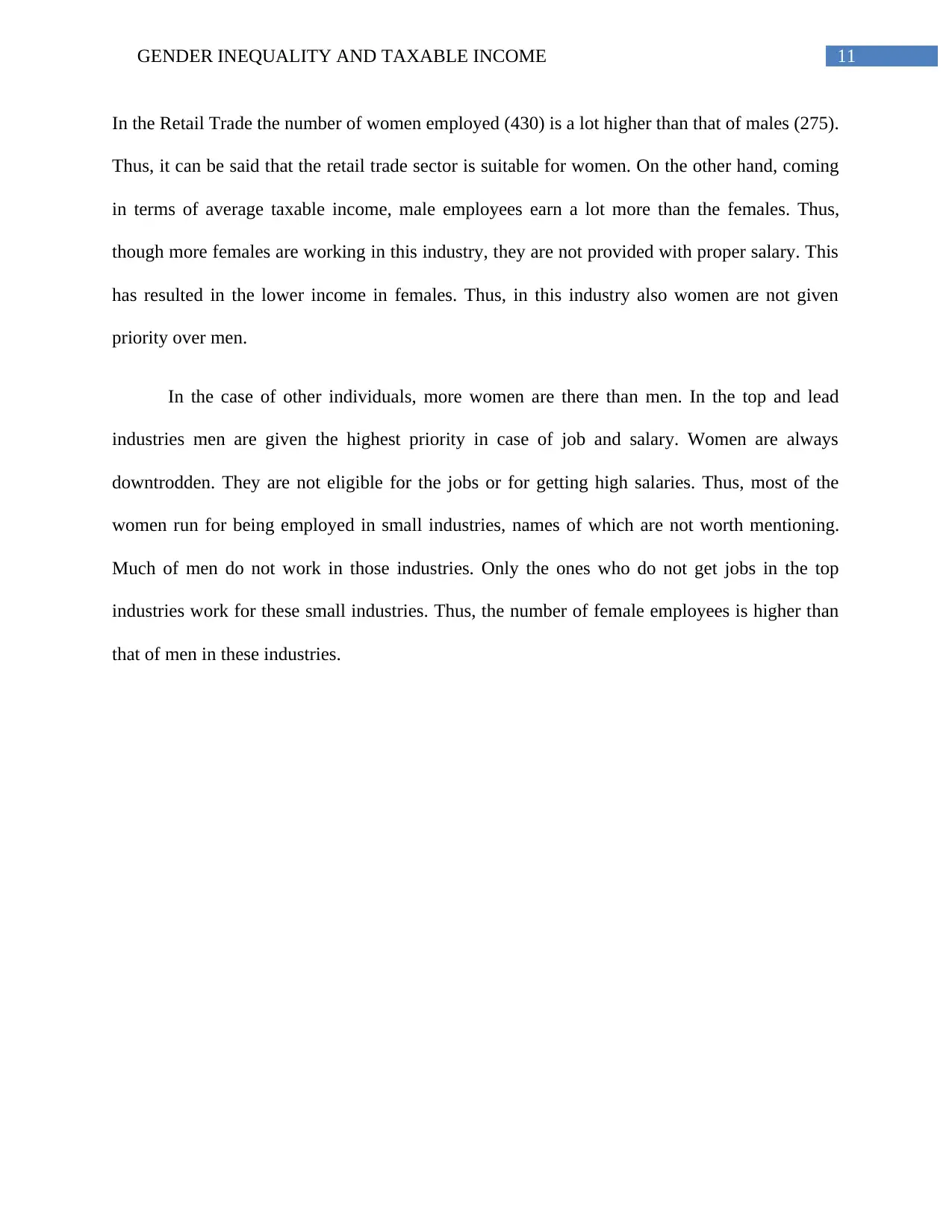
11GENDER INEQUALITY AND TAXABLE INCOME
In the Retail Trade the number of women employed (430) is a lot higher than that of males (275).
Thus, it can be said that the retail trade sector is suitable for women. On the other hand, coming
in terms of average taxable income, male employees earn a lot more than the females. Thus,
though more females are working in this industry, they are not provided with proper salary. This
has resulted in the lower income in females. Thus, in this industry also women are not given
priority over men.
In the case of other individuals, more women are there than men. In the top and lead
industries men are given the highest priority in case of job and salary. Women are always
downtrodden. They are not eligible for the jobs or for getting high salaries. Thus, most of the
women run for being employed in small industries, names of which are not worth mentioning.
Much of men do not work in those industries. Only the ones who do not get jobs in the top
industries work for these small industries. Thus, the number of female employees is higher than
that of men in these industries.
In the Retail Trade the number of women employed (430) is a lot higher than that of males (275).
Thus, it can be said that the retail trade sector is suitable for women. On the other hand, coming
in terms of average taxable income, male employees earn a lot more than the females. Thus,
though more females are working in this industry, they are not provided with proper salary. This
has resulted in the lower income in females. Thus, in this industry also women are not given
priority over men.
In the case of other individuals, more women are there than men. In the top and lead
industries men are given the highest priority in case of job and salary. Women are always
downtrodden. They are not eligible for the jobs or for getting high salaries. Thus, most of the
women run for being employed in small industries, names of which are not worth mentioning.
Much of men do not work in those industries. Only the ones who do not get jobs in the top
industries work for these small industries. Thus, the number of female employees is higher than
that of men in these industries.
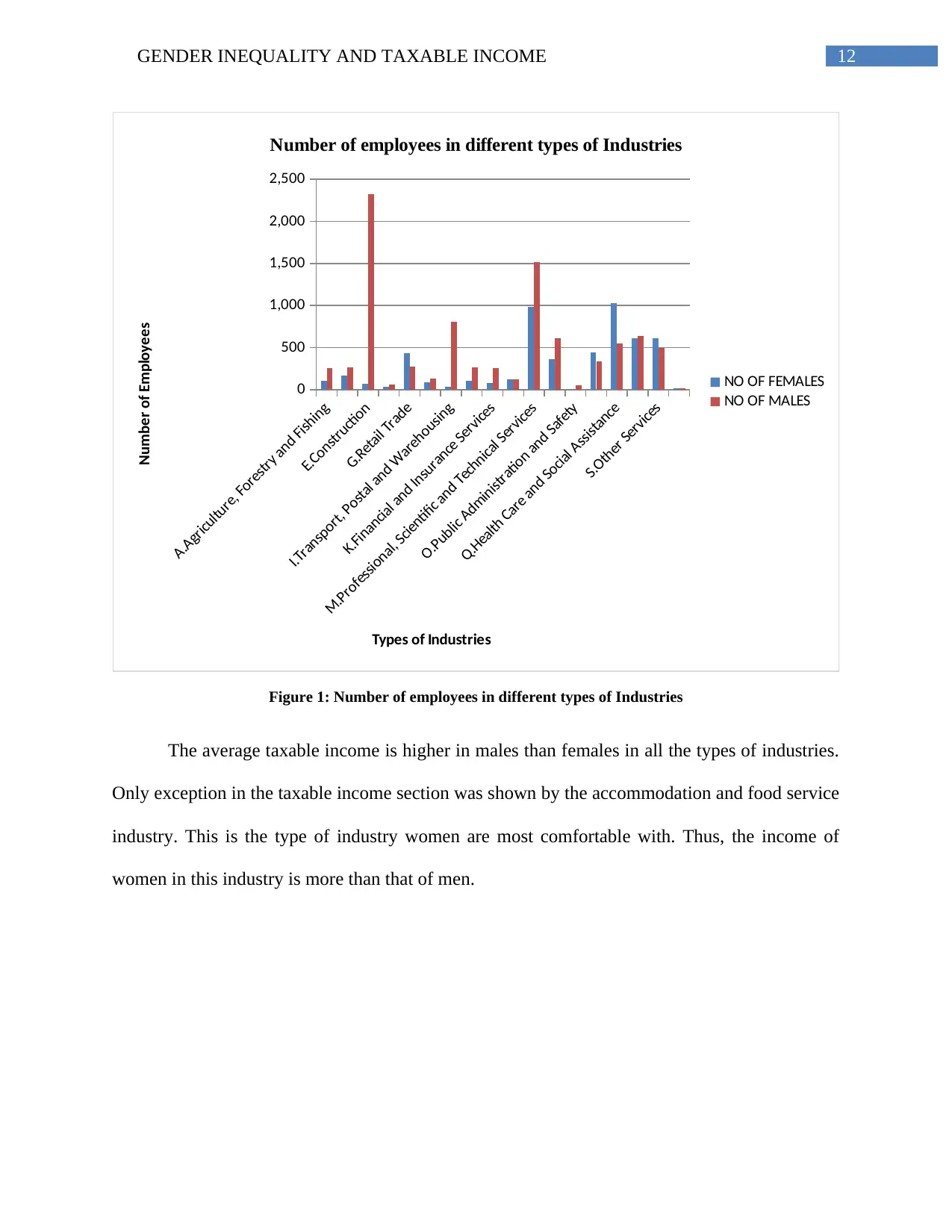
12GENDER INEQUALITY AND TAXABLE INCOME
A.Agriculture, Forestry and Fishing
E.Construction
G.Retail Trade
I.Transport, Postal and Warehousing
K.Financial and Insurance Services
M.Professional, Scientific and Technical Services
O.Public Administration and Safety
Q.Health Care and Social Assistance
S.Other Services
0
500
1,000
1,500
2,000
2,500
Number of employees in different types of Industries
NO OF FEMALES
NO OF MALES
Types of Industries
Number of Employees
Figure 1: Number of employees in different types of Industries
The average taxable income is higher in males than females in all the types of industries.
Only exception in the taxable income section was shown by the accommodation and food service
industry. This is the type of industry women are most comfortable with. Thus, the income of
women in this industry is more than that of men.
A.Agriculture, Forestry and Fishing
E.Construction
G.Retail Trade
I.Transport, Postal and Warehousing
K.Financial and Insurance Services
M.Professional, Scientific and Technical Services
O.Public Administration and Safety
Q.Health Care and Social Assistance
S.Other Services
0
500
1,000
1,500
2,000
2,500
Number of employees in different types of Industries
NO OF FEMALES
NO OF MALES
Types of Industries
Number of Employees
Figure 1: Number of employees in different types of Industries
The average taxable income is higher in males than females in all the types of industries.
Only exception in the taxable income section was shown by the accommodation and food service
industry. This is the type of industry women are most comfortable with. Thus, the income of
women in this industry is more than that of men.
Paraphrase This Document
Need a fresh take? Get an instant paraphrase of this document with our AI Paraphraser
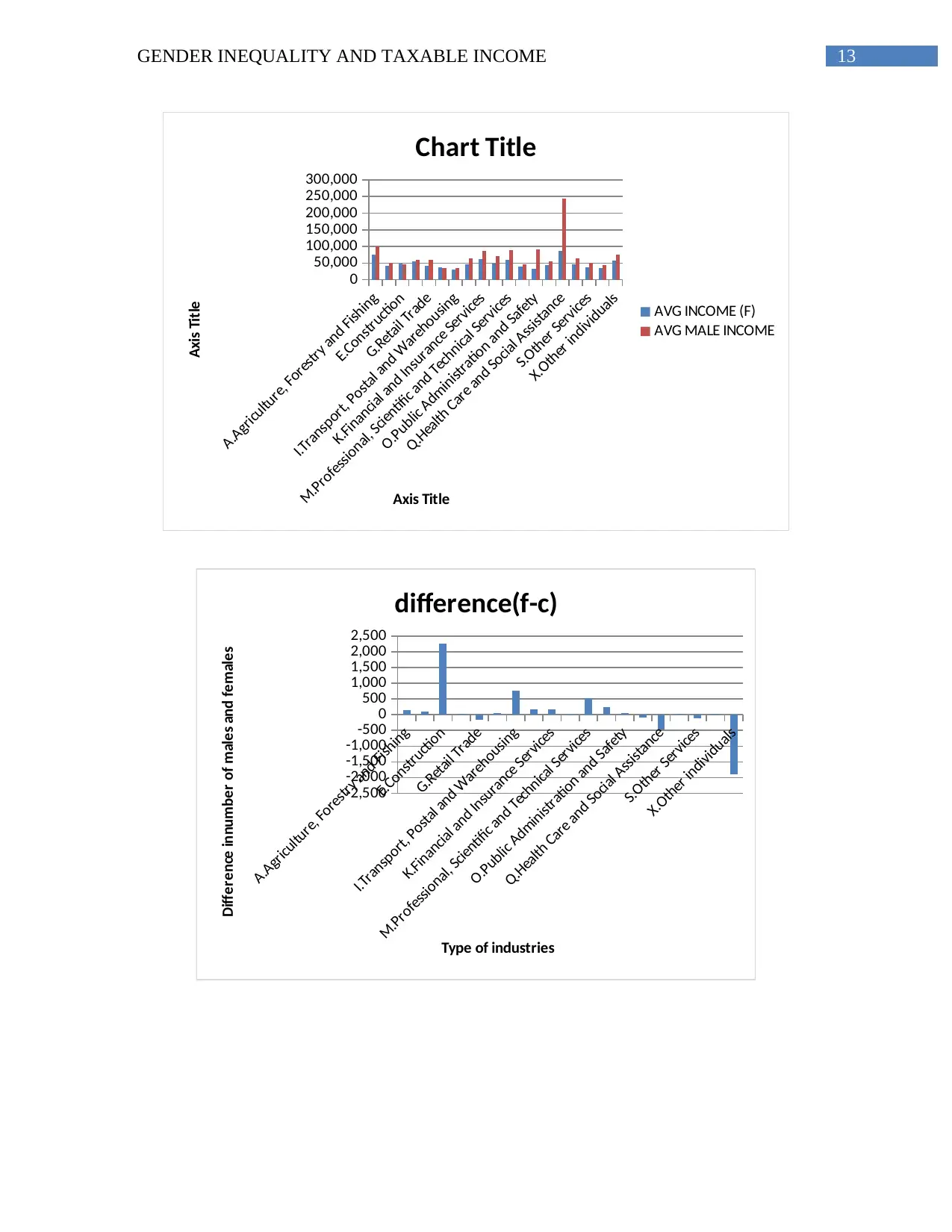
13GENDER INEQUALITY AND TAXABLE INCOME
A.Agriculture, Forestry and Fishing
E.Construction
G.Retail Trade
I.Transport, Postal and Warehousing
K.Financial and Insurance Services
M.Professional, Scientific and Technical Services
O.Public Administration and Safety
Q.Health Care and Social Assistance
S.Other Services
X.Other individuals
0
50,000
100,000
150,000
200,000
250,000
300,000
Chart Title
AVG INCOME (F)
AVG MALE INCOME
Axis Title
Axis Title
A.Agriculture, Forestry and Fishing
E.Construction
G.Retail Trade
I.Transport, Postal and Warehousing
K.Financial and Insurance Services
M.Professional, Scientific and Technical Services
O.Public Administration and Safety
Q.Health Care and Social Assistance
S.Other Services
X.Other individuals
-2,500
-2,000
-1,500
-1,000
-500
0
500
1,000
1,500
2,000
2,500
difference(f-c)
Type of industries
Difference innumber of males and females
A.Agriculture, Forestry and Fishing
E.Construction
G.Retail Trade
I.Transport, Postal and Warehousing
K.Financial and Insurance Services
M.Professional, Scientific and Technical Services
O.Public Administration and Safety
Q.Health Care and Social Assistance
S.Other Services
X.Other individuals
0
50,000
100,000
150,000
200,000
250,000
300,000
Chart Title
AVG INCOME (F)
AVG MALE INCOME
Axis Title
Axis Title
A.Agriculture, Forestry and Fishing
E.Construction
G.Retail Trade
I.Transport, Postal and Warehousing
K.Financial and Insurance Services
M.Professional, Scientific and Technical Services
O.Public Administration and Safety
Q.Health Care and Social Assistance
S.Other Services
X.Other individuals
-2,500
-2,000
-1,500
-1,000
-500
0
500
1,000
1,500
2,000
2,500
difference(f-c)
Type of industries
Difference innumber of males and females
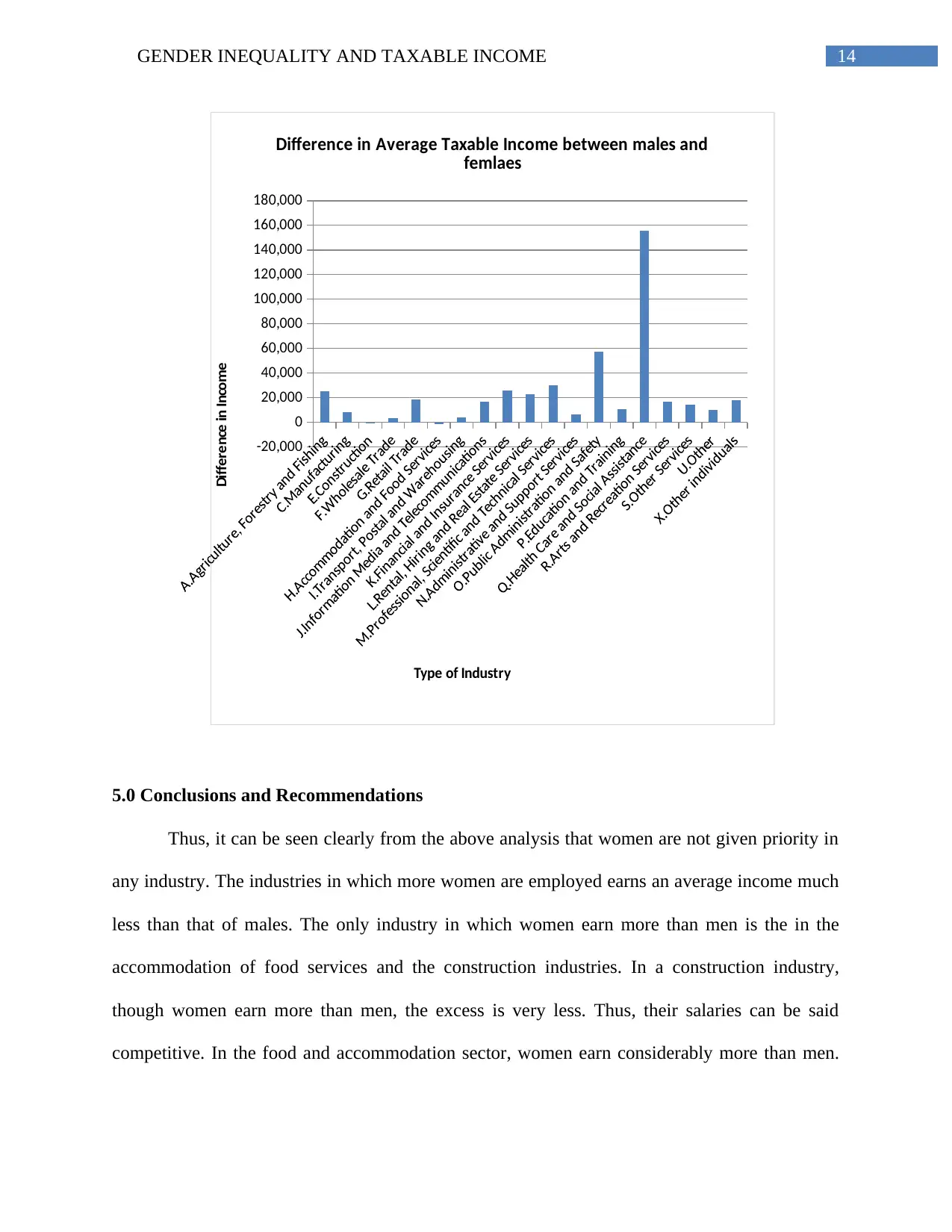
14GENDER INEQUALITY AND TAXABLE INCOME
-20,000
0
20,000
40,000
60,000
80,000
100,000
120,000
140,000
160,000
180,000
Difference in Average Taxable Income between males and
femlaes
Type of Industry
Difference in Income
5.0 Conclusions and Recommendations
Thus, it can be seen clearly from the above analysis that women are not given priority in
any industry. The industries in which more women are employed earns an average income much
less than that of males. The only industry in which women earn more than men is the in the
accommodation of food services and the construction industries. In a construction industry,
though women earn more than men, the excess is very less. Thus, their salaries can be said
competitive. In the food and accommodation sector, women earn considerably more than men.
-20,000
0
20,000
40,000
60,000
80,000
100,000
120,000
140,000
160,000
180,000
Difference in Average Taxable Income between males and
femlaes
Type of Industry
Difference in Income
5.0 Conclusions and Recommendations
Thus, it can be seen clearly from the above analysis that women are not given priority in
any industry. The industries in which more women are employed earns an average income much
less than that of males. The only industry in which women earn more than men is the in the
accommodation of food services and the construction industries. In a construction industry,
though women earn more than men, the excess is very less. Thus, their salaries can be said
competitive. In the food and accommodation sector, women earn considerably more than men.
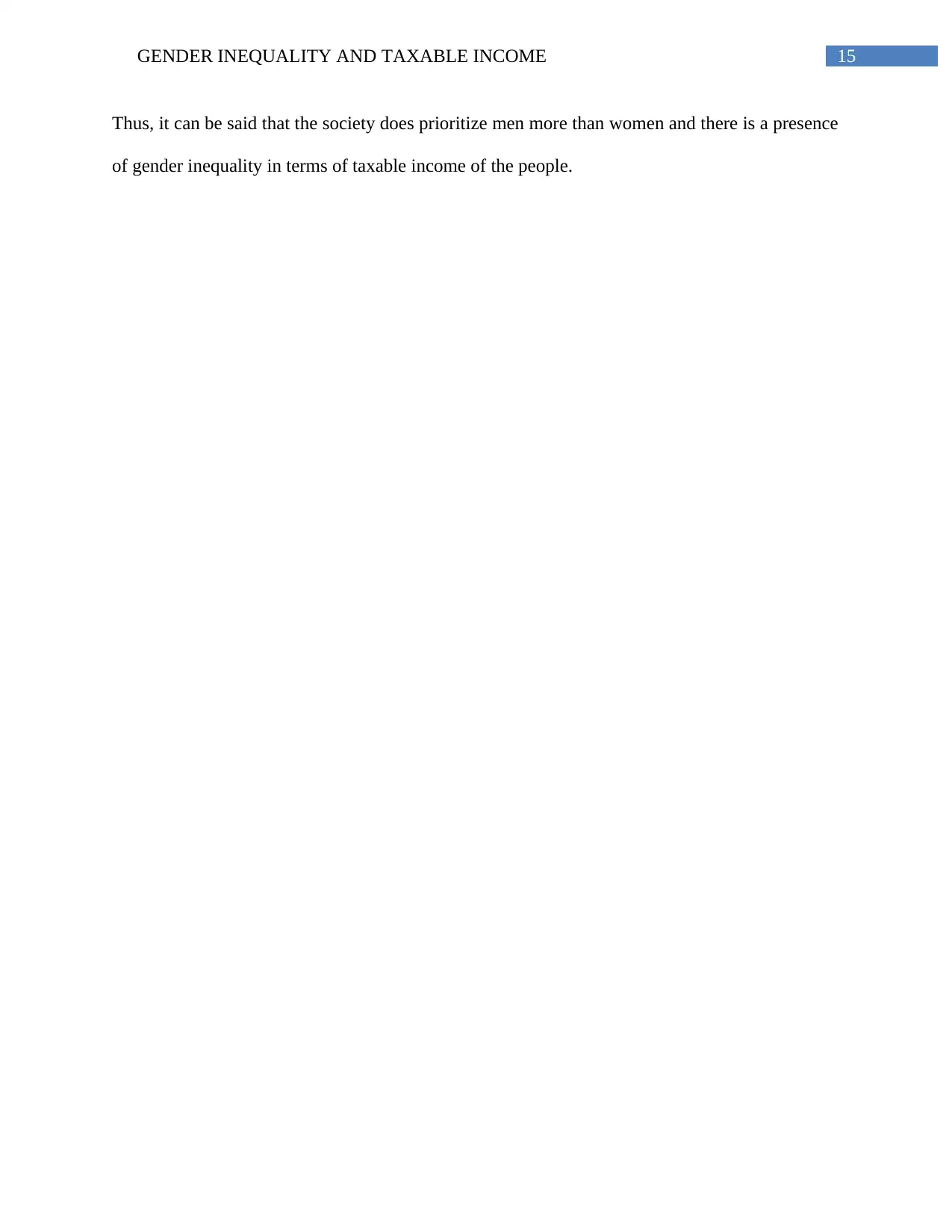
15GENDER INEQUALITY AND TAXABLE INCOME
Thus, it can be said that the society does prioritize men more than women and there is a presence
of gender inequality in terms of taxable income of the people.
Thus, it can be said that the society does prioritize men more than women and there is a presence
of gender inequality in terms of taxable income of the people.
Secure Best Marks with AI Grader
Need help grading? Try our AI Grader for instant feedback on your assignments.
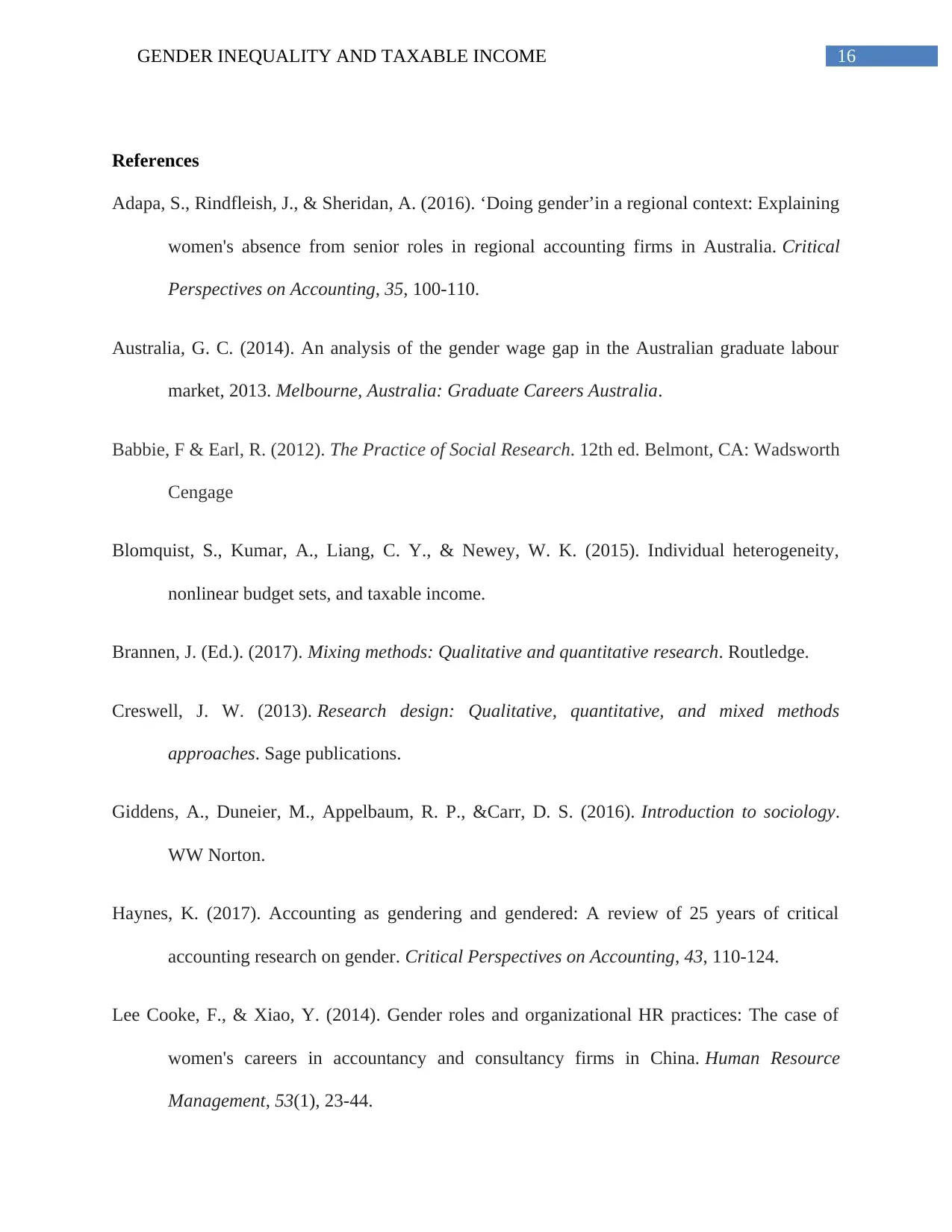
16GENDER INEQUALITY AND TAXABLE INCOME
References
Adapa, S., Rindfleish, J., & Sheridan, A. (2016). ‘Doing gender’in a regional context: Explaining
women's absence from senior roles in regional accounting firms in Australia. Critical
Perspectives on Accounting, 35, 100-110.
Australia, G. C. (2014). An analysis of the gender wage gap in the Australian graduate labour
market, 2013. Melbourne, Australia: Graduate Careers Australia.
Babbie, F & Earl, R. (2012). The Practice of Social Research. 12th ed. Belmont, CA: Wadsworth
Cengage
Blomquist, S., Kumar, A., Liang, C. Y., & Newey, W. K. (2015). Individual heterogeneity,
nonlinear budget sets, and taxable income.
Brannen, J. (Ed.). (2017). Mixing methods: Qualitative and quantitative research. Routledge.
Creswell, J. W. (2013). Research design: Qualitative, quantitative, and mixed methods
approaches. Sage publications.
Giddens, A., Duneier, M., Appelbaum, R. P., &Carr, D. S. (2016). Introduction to sociology.
WW Norton.
Haynes, K. (2017). Accounting as gendering and gendered: A review of 25 years of critical
accounting research on gender. Critical Perspectives on Accounting, 43, 110-124.
Lee Cooke, F., & Xiao, Y. (2014). Gender roles and organizational HR practices: The case of
women's careers in accountancy and consultancy firms in China. Human Resource
Management, 53(1), 23-44.
References
Adapa, S., Rindfleish, J., & Sheridan, A. (2016). ‘Doing gender’in a regional context: Explaining
women's absence from senior roles in regional accounting firms in Australia. Critical
Perspectives on Accounting, 35, 100-110.
Australia, G. C. (2014). An analysis of the gender wage gap in the Australian graduate labour
market, 2013. Melbourne, Australia: Graduate Careers Australia.
Babbie, F & Earl, R. (2012). The Practice of Social Research. 12th ed. Belmont, CA: Wadsworth
Cengage
Blomquist, S., Kumar, A., Liang, C. Y., & Newey, W. K. (2015). Individual heterogeneity,
nonlinear budget sets, and taxable income.
Brannen, J. (Ed.). (2017). Mixing methods: Qualitative and quantitative research. Routledge.
Creswell, J. W. (2013). Research design: Qualitative, quantitative, and mixed methods
approaches. Sage publications.
Giddens, A., Duneier, M., Appelbaum, R. P., &Carr, D. S. (2016). Introduction to sociology.
WW Norton.
Haynes, K. (2017). Accounting as gendering and gendered: A review of 25 years of critical
accounting research on gender. Critical Perspectives on Accounting, 43, 110-124.
Lee Cooke, F., & Xiao, Y. (2014). Gender roles and organizational HR practices: The case of
women's careers in accountancy and consultancy firms in China. Human Resource
Management, 53(1), 23-44.
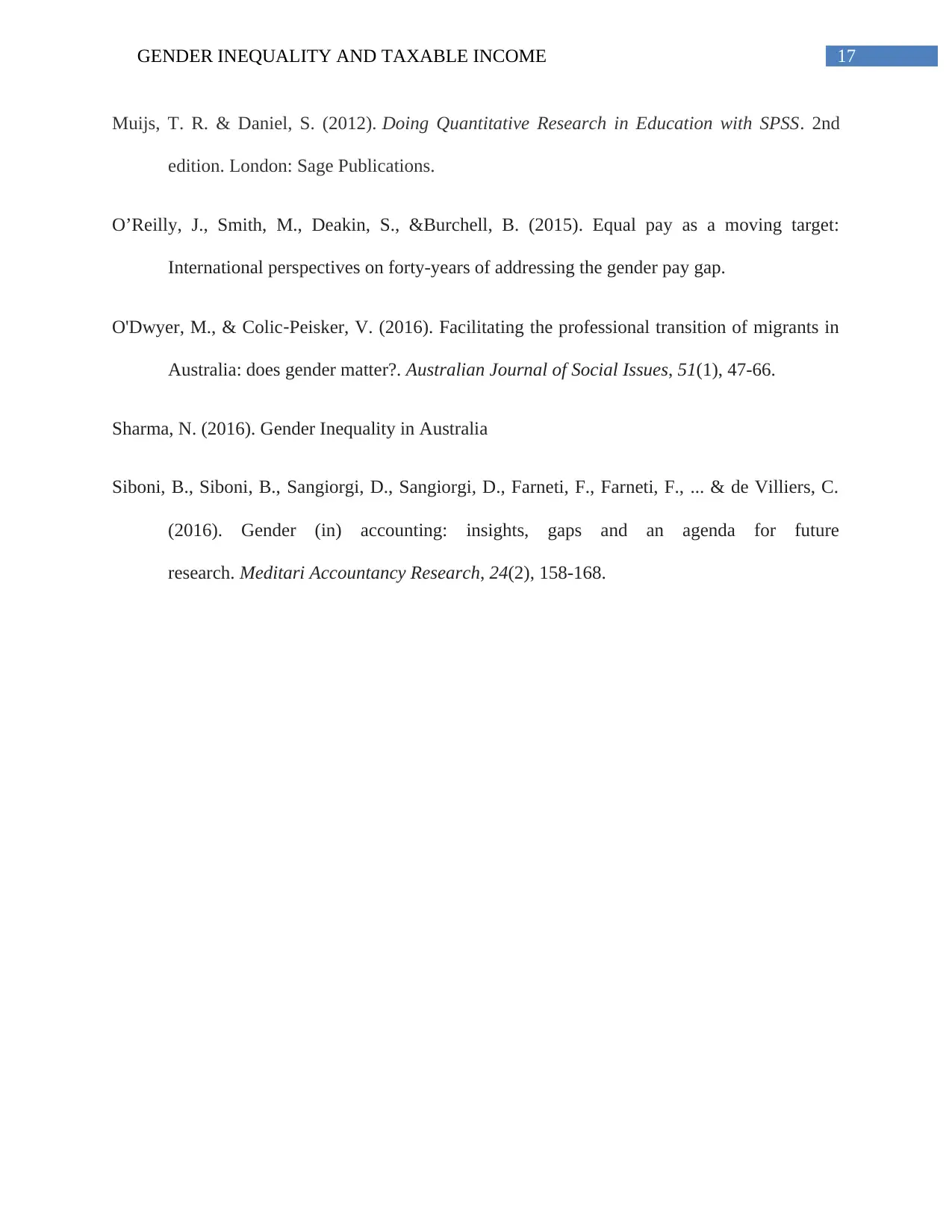
17GENDER INEQUALITY AND TAXABLE INCOME
Muijs, T. R. & Daniel, S. (2012). Doing Quantitative Research in Education with SPSS. 2nd
edition. London: Sage Publications.
O’Reilly, J., Smith, M., Deakin, S., &Burchell, B. (2015). Equal pay as a moving target:
International perspectives on forty-years of addressing the gender pay gap.
O'Dwyer, M., & Colic‐Peisker, V. (2016). Facilitating the professional transition of migrants in
Australia: does gender matter?. Australian Journal of Social Issues, 51(1), 47-66.
Sharma, N. (2016). Gender Inequality in Australia
Siboni, B., Siboni, B., Sangiorgi, D., Sangiorgi, D., Farneti, F., Farneti, F., ... & de Villiers, C.
(2016). Gender (in) accounting: insights, gaps and an agenda for future
research. Meditari Accountancy Research, 24(2), 158-168.
Muijs, T. R. & Daniel, S. (2012). Doing Quantitative Research in Education with SPSS. 2nd
edition. London: Sage Publications.
O’Reilly, J., Smith, M., Deakin, S., &Burchell, B. (2015). Equal pay as a moving target:
International perspectives on forty-years of addressing the gender pay gap.
O'Dwyer, M., & Colic‐Peisker, V. (2016). Facilitating the professional transition of migrants in
Australia: does gender matter?. Australian Journal of Social Issues, 51(1), 47-66.
Sharma, N. (2016). Gender Inequality in Australia
Siboni, B., Siboni, B., Sangiorgi, D., Sangiorgi, D., Farneti, F., Farneti, F., ... & de Villiers, C.
(2016). Gender (in) accounting: insights, gaps and an agenda for future
research. Meditari Accountancy Research, 24(2), 158-168.
1 out of 18
Related Documents
Your All-in-One AI-Powered Toolkit for Academic Success.
+13062052269
info@desklib.com
Available 24*7 on WhatsApp / Email
![[object Object]](/_next/static/media/star-bottom.7253800d.svg)
Unlock your academic potential
© 2024 | Zucol Services PVT LTD | All rights reserved.




